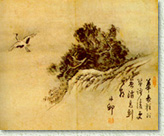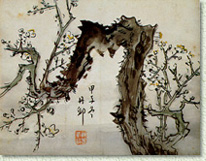
|
Paintings Kim Hong Do (Danwon)'s Virtual Gallery Kim Hong Do was first artist to pave the way for Korean traditional painting. He was one of the best 3 painters of the Chosun period. He did not abide with the Chinese ways of painting, a style that was popular at that time. He used his creativity and came up with a distinct Korean style. He composed his object in the center or where it was easily to be caught by the eye, If you look at his drawings closely, you can tell cach object he drew has its own importance. |
|
His main object of protrayal in the painting "Samkong Bulhwando" is the large tiled house
on the right side. To make the house stand out, he added a garden on the left side and on
the right he drew an entrance to a mountain with a "chungja" which is a pavilion for resting.
With the house seperating the right side and left side, each has its own principle and
meaning.
In "Pyongyang Kamsahyangdo" or When drawing paintings depicting folk customs, he drew many people. The paintings might look like there is one area that stands out but when you look closely, you can see that each person drawn has its own significance. In his paintings of folk customs, for instance, wrestling or pictures of people dancing, there are some people that act different. But this does not break the order of the painting but lets the main idea stand out and inhibits laughter.
His major pieces are 'Blacksmith's Shop', 'Laundry Site', 'Hwahwae Chungjungdo'
|

|
Chookhodo (Bamboo and Tiger) 34cm,91cm This painting with the bamboo on top and the tiger in the bottom, you see Kim Hong Do's strength by the culed up lion and the stretched out bamboo. |
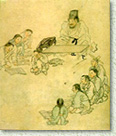 |
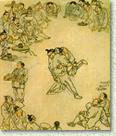 |
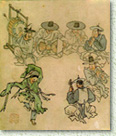 |
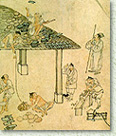 |

|

